Mt Sherman Hike - Aug 27, 2000
Mt Sherman, Colorado
Near Fairplay, Colorado
August 27, 2000
I started thinking about operating from the peak of one of Colorado's 14ers
when I first got enthused about QRP radio 2 or 3 years ago. In some of my
more fanciful daydreams I had visions of contacts from the summit of each
and every one of the 59 mountains that are higher the 14000 feet in Colorado.
As it worked out I never made it to the top of a 14er with my QRP rig until
just recently. Part of the reason was that I found many other QRP activities
to occupy my time. Part of the reason was that, even though I hiked a couple
14ers in that time, I never had quite the antenna I needed to operate from
the summit. I've got the usual array of portable antennas: wire verticals,
wire dipoles, half wave wires with small tuners, black widow fishing pole,
Kanga pole, etc, but the environment at the summit is unique. Naturally,
there are no trees to string wires in. The ground is pure rock without even
a trace of soil to hold a stake so it's difficult to put up a pole with staked
guy wires. The thin air leaves an old guy like me gasping the last several
hundred feet carrying just myself up, let alone a lot of extra ham radio
gear. So, my requirements for an antenna were to be very lightweight, easy
to carry AND completely self-supporting.
Sunday, August 27 was the day I finally operated QRP from a summit. The week
before I had talked my xyl and a friend into hiking Mt Sherman (14036 ft)
with me. On Friday I started thinking about how to operate from the top and
(don't tell my boss) spent a little time at work designing antennas. My design
was based around a hustler 20-meter resonator. The general idea was to mount
the resonator on a piece of 1/2" copper pipe. A piece of 3/4" PVC would serve
as a short mast for the antenna so that it could be slightly elevated, allowing
me to have elevated radials. The PVC mast would have a tripod at the bottom
made of 3/8" threaded rod, which
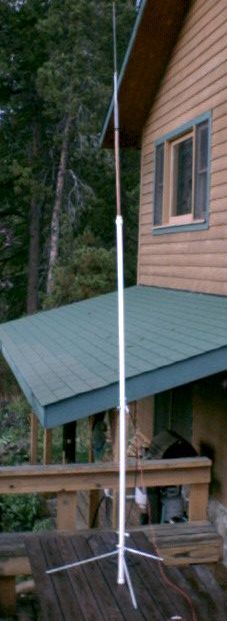 would simply be pushed through holes drilled at
an angle at the bottom of the mast. Feed line and radials would be connected
to small bolts put through the PVC and copper pipe. Three 1/4-wave radials
would be attached at the site using alligator clips. For hiking, the copper
pipe would slide inside the PVC, the 3 threaded rods would slide inside the
copper pipe and the resonator would slide into the PVC on top of the copper
pipe. One side of the mast would have a permanent PVC cap and the
would simply be pushed through holes drilled at
an angle at the bottom of the mast. Feed line and radials would be connected
to small bolts put through the PVC and copper pipe. Three 1/4-wave radials
would be attached at the site using alligator clips. For hiking, the copper
pipe would slide inside the PVC, the 3 threaded rods would slide inside the
copper pipe and the resonator would slide into the PVC on top of the copper
pipe. One side of the mast would have a permanent PVC cap and the
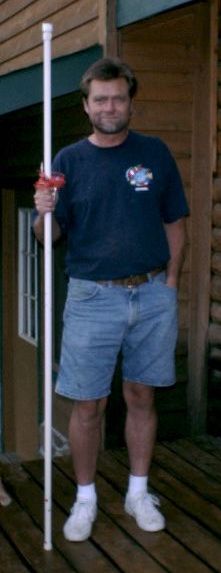 other side
would have a screw off PVC cap. The whole thing should function as a walking
stick when packed up.
other side
would have a screw off PVC cap. The whole thing should function as a walking
stick when packed up.
On Saturday afternoon, I hit the hardware store for parts and got started
building. It went together pretty smoothly. The most difficult part was drilling
the angled holes for the tripod legs and getting them roughly at 120 degree
angles from each other (I think mine vary from about 150 degrees to 100 degrees).
The whole thing ended up needing to be a little taller then a standard walking
stick, about 6'6", and is not really sturdy enough to be a good walking stick.
But it made it to the top with me and even proved pretty darn functional
on a couple of the steeper spots coming down. If you would like more details
of the construction feel free to contact me.
Sunday the weather report called for thunderstorms in the afternoon. Many
a 14er hiker has been forced to turn around before reaching the summit because
of dark clouds in the distance. Not wanting this to be our fate, we left
the house at 4:00 AM in order to be on the trail by 6:00 AM. I thought we'd
be able to reach the summit, make a few QSO's and get down before any
thunderstorms rolled in. We arrived at the trailhead. We were in a huge bowl
formed by four
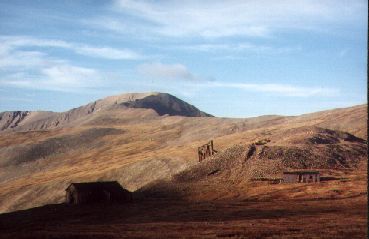 tremendous peaks looming over us. We picked the tallest one
and headed toward it. We were on the trail just as it was getting light.
tremendous peaks looming over us. We picked the tallest one
and headed toward it. We were on the trail just as it was getting light.
This peak is just above the old deserted mining town of Leavick. The sides
of the four mountain peaks are littered with the remnants of mines and miners:
machinery, miners cribs, mine heads, etc. Already panting from the thin air
we stopped at several of these for pictures and history lessons. These old
mining areas tend to be criss-crossed with old 4 wheel drive trails and we
had some trouble deciding which trail would lead us to our peak.
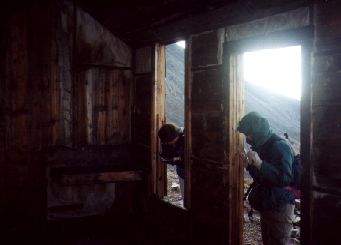 After a short conference we very democratically cast our votes,
picked a trail and moved on. Soon we were cresting a saddle just to the west
of the peak. We had been surprised at the low temperature and stiff breeze
from the start of the hike. Once above the ridge the wind immediately picked
up to what felt like a gale. Keeping below the ridge helped some but we hiked
in a very stiff wind until we reached the summit. I started wondering how
my little homebrew vertical was going to stand up to
After a short conference we very democratically cast our votes,
picked a trail and moved on. Soon we were cresting a saddle just to the west
of the peak. We had been surprised at the low temperature and stiff breeze
from the start of the hike. Once above the ridge the wind immediately picked
up to what felt like a gale. Keeping below the ridge helped some but we hiked
in a very stiff wind until we reached the summit. I started wondering how
my little homebrew vertical was going to stand up to
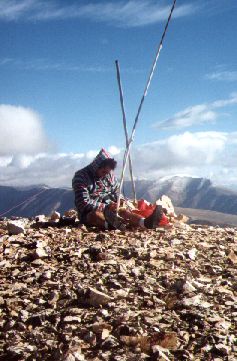 the
weather.
the
weather.
I hurried to get to the summit before the other two, hoping I could get set
up before the arrived and not make them wait around too long as I did my
'radio thing'. On the summit, first things first. Every summit has a registry
rolled up in a waterproof container. Anyone who reaches the top has the privilege
of signing as proof they were there. This done, I unpacked my sw20, radio
shack mini-earphones, white rock paddle with built in tick keyer, 10AA battery
pack and, of course, the antenna. All was together in less then 10 minutes
I'm sure. I quickly discovered that the little antenna tripod that felt so
firm on my front deck was not even close to holding up the antenna in this
wind. I sat down at the base, tipped the antenna up and wrapped my legs around
the tripod to hold the whole thing up. This is
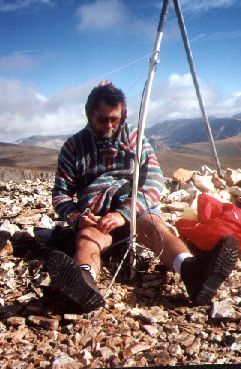 when my
wife arrived and started taking some of the accompanying photos. I was AMAZED
at the performance of the antenna at this site. It can only be explained
by the very steep, very high drop offs for about 320 degrees around me. In
a period of about 20 minutes I worked 4 QSO's (K8JPG, AB5TY, K6III, WA5DTK)
in TX, CA and IN and got 3 599 reports and 1 589 report. Moral of that story:
any antenna that works is a good antenna. I would have loved to work longer
but, sitting in one spot in my shorts and without gloves on, I couldn't stand
the wind and cold. I packed up the rig and antenna, took a couple more pictures,
and we were
when my
wife arrived and started taking some of the accompanying photos. I was AMAZED
at the performance of the antenna at this site. It can only be explained
by the very steep, very high drop offs for about 320 degrees around me. In
a period of about 20 minutes I worked 4 QSO's (K8JPG, AB5TY, K6III, WA5DTK)
in TX, CA and IN and got 3 599 reports and 1 589 report. Moral of that story:
any antenna that works is a good antenna. I would have loved to work longer
but, sitting in one spot in my shorts and without gloves on, I couldn't stand
the wind and cold. I packed up the rig and antenna, took a couple more pictures,
and we were
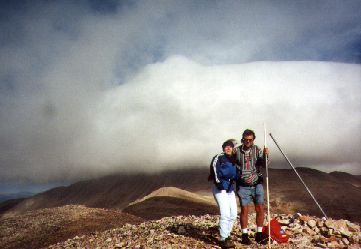 off
to find the path down.
off
to find the path down.
We had been pleased all day that we had the mountain to ourselves. Now, as
the blanket of clouds blew off of the peak next to us, we noticed a lot of
people on that peak. Funny that they would be crowded around the top of a
lesser mountain then our huge Mt Sherman. Should we holler at them and urge
them over to join
us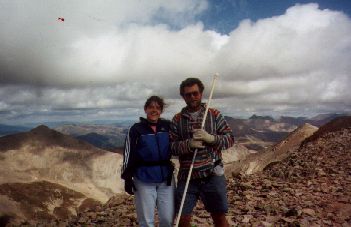 in conquering a 14er or should we….. take another look
at the map.
in conquering a 14er or should we….. take another look
at the map.
Sure enough, we had conquered not a 14er but a 13er, White Ridge at 13,684
feet. We were three tired hikers, but as close as we were we felt we had
to 'bag' the 14er so off we went to the real Mt Sherman. This only ended
up adding an hour or so to our hike and the beautiful views from the top
of Mt Sherman were well worth it. No, I still haven't operated from the top
of a 14er. When we got there, the wind had finally died down, and I was ready
to just sit back and enjoy the moment. However, my 'mountain topper' antenna
has proved itself and the next time I'll have all
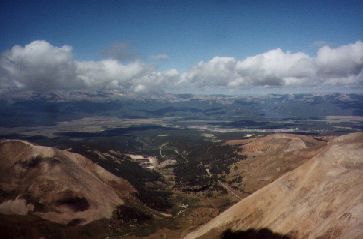 the
equipment I need at my fingertips. Expect to hear a CQ from N0SXX at 14000+
very soon
the
equipment I need at my fingertips. Expect to hear a CQ from N0SXX at 14000+
very soon
 would simply be pushed through holes drilled at
an angle at the bottom of the mast. Feed line and radials would be connected
to small bolts put through the PVC and copper pipe. Three 1/4-wave radials
would be attached at the site using alligator clips. For hiking, the copper
pipe would slide inside the PVC, the 3 threaded rods would slide inside the
copper pipe and the resonator would slide into the PVC on top of the copper
pipe. One side of the mast would have a permanent PVC cap and the
would simply be pushed through holes drilled at
an angle at the bottom of the mast. Feed line and radials would be connected
to small bolts put through the PVC and copper pipe. Three 1/4-wave radials
would be attached at the site using alligator clips. For hiking, the copper
pipe would slide inside the PVC, the 3 threaded rods would slide inside the
copper pipe and the resonator would slide into the PVC on top of the copper
pipe. One side of the mast would have a permanent PVC cap and the
 other side
would have a screw off PVC cap. The whole thing should function as a walking
stick when packed up.
other side
would have a screw off PVC cap. The whole thing should function as a walking
stick when packed up.
 tremendous peaks looming over us. We picked the tallest one
and headed toward it. We were on the trail just as it was getting light.
tremendous peaks looming over us. We picked the tallest one
and headed toward it. We were on the trail just as it was getting light.
 After a short conference we very democratically cast our votes,
picked a trail and moved on. Soon we were cresting a saddle just to the west
of the peak. We had been surprised at the low temperature and stiff breeze
from the start of the hike. Once above the ridge the wind immediately picked
up to what felt like a gale. Keeping below the ridge helped some but we hiked
in a very stiff wind until we reached the summit. I started wondering how
my little homebrew vertical was going to stand up to
After a short conference we very democratically cast our votes,
picked a trail and moved on. Soon we were cresting a saddle just to the west
of the peak. We had been surprised at the low temperature and stiff breeze
from the start of the hike. Once above the ridge the wind immediately picked
up to what felt like a gale. Keeping below the ridge helped some but we hiked
in a very stiff wind until we reached the summit. I started wondering how
my little homebrew vertical was going to stand up to
 the
weather.
the
weather.
 when my
wife arrived and started taking some of the accompanying photos. I was AMAZED
at the performance of the antenna at this site. It can only be explained
by the very steep, very high drop offs for about 320 degrees around me. In
a period of about 20 minutes I worked 4 QSO's (K8JPG, AB5TY, K6III, WA5DTK)
in TX, CA and IN and got 3 599 reports and 1 589 report. Moral of that story:
any antenna that works is a good antenna. I would have loved to work longer
but, sitting in one spot in my shorts and without gloves on, I couldn't stand
the wind and cold. I packed up the rig and antenna, took a couple more pictures,
and we were
when my
wife arrived and started taking some of the accompanying photos. I was AMAZED
at the performance of the antenna at this site. It can only be explained
by the very steep, very high drop offs for about 320 degrees around me. In
a period of about 20 minutes I worked 4 QSO's (K8JPG, AB5TY, K6III, WA5DTK)
in TX, CA and IN and got 3 599 reports and 1 589 report. Moral of that story:
any antenna that works is a good antenna. I would have loved to work longer
but, sitting in one spot in my shorts and without gloves on, I couldn't stand
the wind and cold. I packed up the rig and antenna, took a couple more pictures,
and we were
 off
to find the path down.
off
to find the path down.
 in conquering a 14er or should we….. take another look
at the map.
in conquering a 14er or should we….. take another look
at the map.
 the
equipment I need at my fingertips. Expect to hear a CQ from N0SXX at 14000+
very soon
the
equipment I need at my fingertips. Expect to hear a CQ from N0SXX at 14000+
very soon